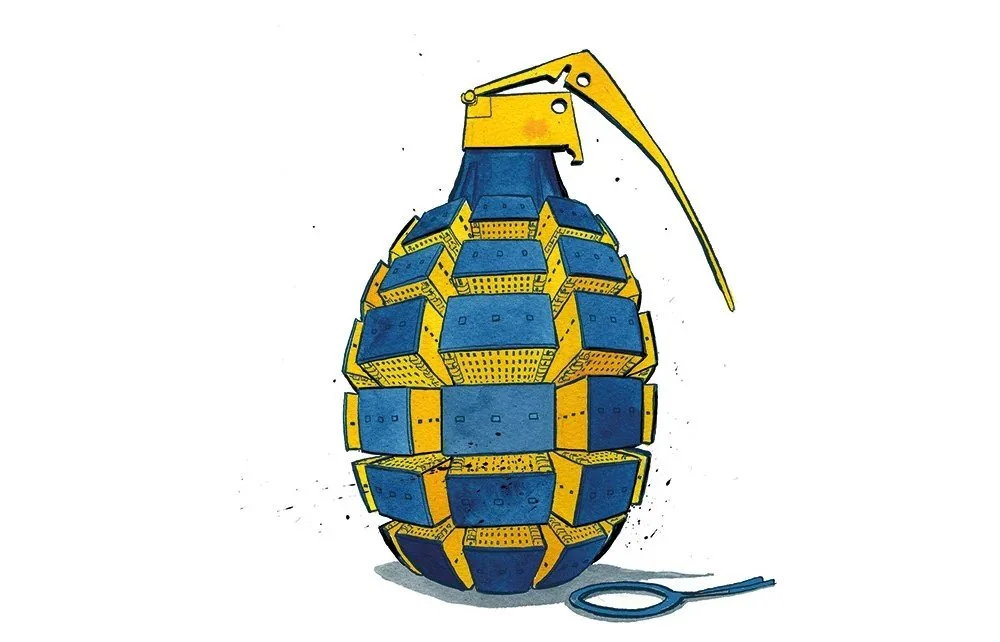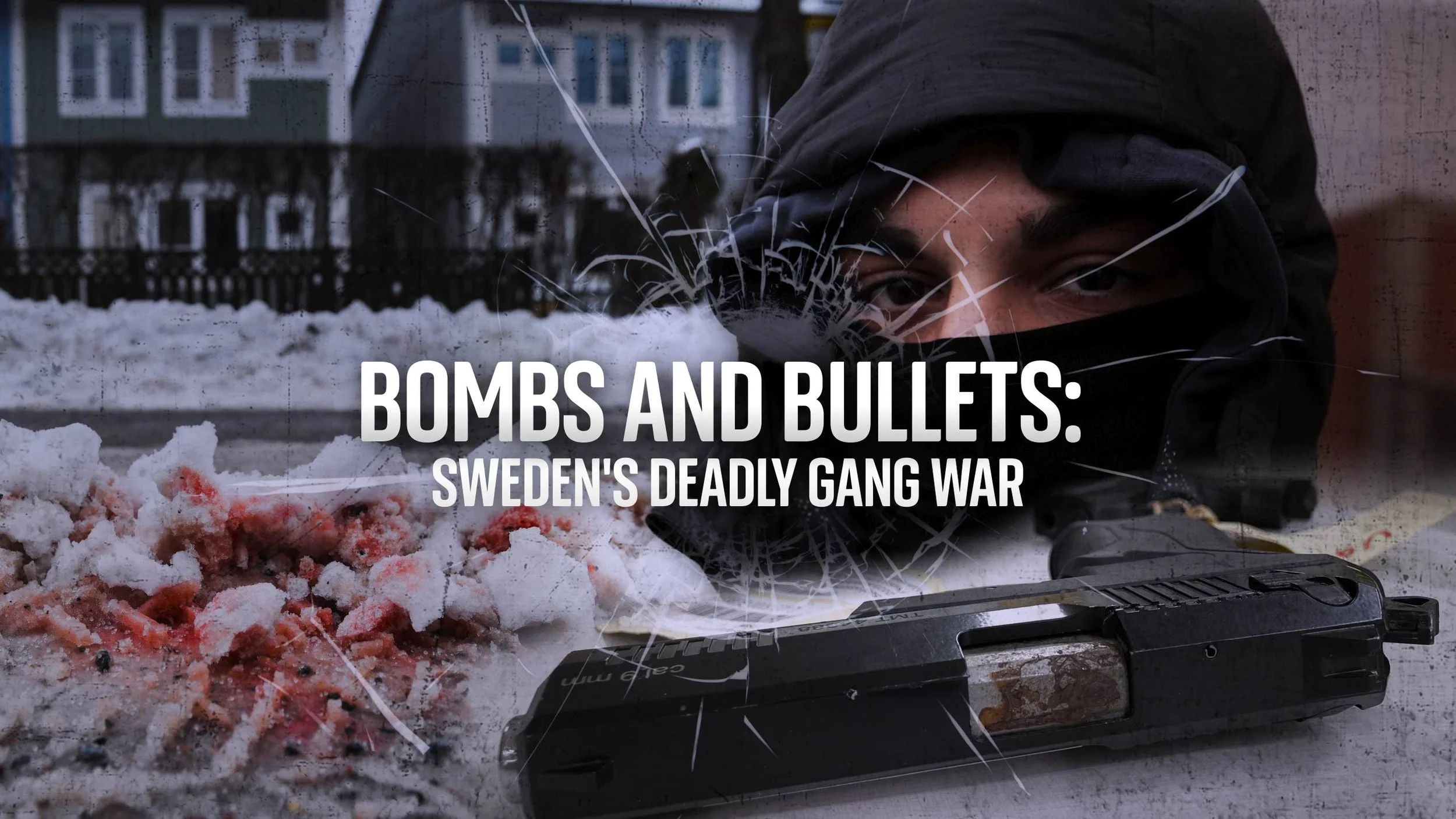From Peaceful Image to Gang Crisis: Lessons for New Zealand from Sweden's Gang Violence problems
Introduction
New Zealand has recently faced an evolving gang landscape, partly influenced by Australia's 501 deportation policy. This policy, implemented in December 2014, has resulted in over 3,000 deportees being sent to New Zealand, many of whom have minimal ties to the country but bring sophisticated criminal techniques and international connections. Alarmingly, nearly 50% of these deportees have re-offended, contributing to over 21,404 offences, including violent crimes and drug offences.
Across the globe, Sweden has witnessed a troubling rise in gang violence over the past decade. With a population of 10.49 million, Sweden has seen an increase in firearm homicides, grenade attacks, and gang-related activities, which have shocked a society previously known for its safety and low crime rates. This surge has been partly attributed to challenges in integrating a large number of asylum seekers, economic disparities, and legal system limitations.
This blog explores the lessons New Zealand can learn from Sweden's experience with gang violence and integration challenges. By analysing the factors contributing to Sweden's current situation and the measures taken to address them, New Zealand can adopt proactive strategies to manage and prevent similar issues, particularly in light of the complexities introduced by the influx of 501 deportees.
Section 1: Overview of Sweden's Gang Problem
Background
In recent years, Sweden has experienced a significant increase in gang-related violence, a stark contrast to its once-peaceful reputation. Statistics reveal a worrying trend: in 2022, the country recorded 391 shootings, resulting in over 60 deaths; in 2023, there were 363 shootings with 53 fatalities, making Sweden one of the worst-affected countries in the European Union in terms of firearm homicides per capita. This surge in violence has been marked by not only shootings but also bombings and grenade attacks, incidents once rare in Swedish society. Particularly alarming is the involvement of youth in these activities, with reports indicating that children as young as 13 are being drawn into gang life. This involvement has escalated to tragic outcomes, including instances of teenagers being both perpetrators and victims of severe violence.
Contributing Factors
Several interrelated factors have contributed to the rise in gang violence in Sweden. A significant challenge has been the integration of a large number of asylum seekers and immigrants, particularly following the 2015 European migrant crisis. Between 2015 and 2016, Sweden received over 160,000 asylum applications, with the majority of asylum seekers coming from countries such as Syria, Afghanistan, and Iraq. Many of these individuals have settled in segregated neighbourhoods with limited access to education and employment opportunities, creating environments where young people are vulnerable to gang recruitment.
Socioeconomic disparities have exacerbated feelings of marginalisation and exclusion, further fuelling the problem. The Swedish legal system has also faced scrutiny, particularly for its lenient treatment of young offenders, which some argue has failed to deter criminal activities effectively.
Additionally, Sweden faces challenges in preventing the smuggling of weapons and illegal goods through its extensive Baltic coastline, highlighting the need for robust maritime security measures. These factors, combined with an underfunded and understaffed police force, have created a complex and challenging landscape for managing and reducing gang-related violence.
Section 2: Key Lessons from Sweden
Integration Challenges
One of the primary lessons from Sweden's experience with rising gang violence is the critical importance of effectively integrating immigrants into society. The influx of refugees and asylum seekers, particularly following the 2015 European migrant crisis, led to significant challenges in providing adequate housing, education, and employment opportunities. Many immigrants ended up in economically disadvantaged neighbourhoods with limited access to quality education and job opportunities, exacerbating feelings of marginalisation and exclusion. These areas became fertile ground for gang recruitment as young people, struggling with a lack of prospects and social inclusion, sought a sense of belonging and status. Sweden's experience underscores the necessity of investing in comprehensive integration programs that include language training, educational support, and pathways to employment to prevent the social isolation that can lead to gang involvement.
Youth Engagement
The role of youth in Sweden's gang issues has highlighted the need for proactive engagement strategies. Many individuals involved in gang activities are young, with some as young as 13 years old being drawn into criminal enterprises. The allure of quick wealth, coupled with a lack of positive role models and alternative pathways, has made gangs an attractive option for many young people. To combat this, Sweden's experience suggests the importance of robust youth engagement programs that offer mentorship, educational support, and recreational activities. Community centres, sports clubs, and after-school programs can provide safe spaces and constructive outlets for young people, steering them away from the lure of gang life. Additionally, involving former gang members in outreach programs can be an effective strategy to dissuade youth from joining gangs by sharing real-life consequences and promoting alternative lifestyles.
Reflecting on the complexities of gang recruitment, it is crucial to acknowledge that punitive measures alone cannot solve this problem. As one insightful comment noted, "You cannot punish away this problem because, for every kid you lock up, there are three new [children] coming." This sentiment is underscored by a tragic incident in April 2024, where a 39-year-old Polish man was fatally shot in Stockholm following a confrontation with a group of youths. The man, accompanied by his 12-year-old son, was en route to a swimming pool when the confrontation escalated, resulting in his death. The shooting, witnessed by his son, drew a strong reaction from Swedish Prime Minister Ulf Kristersson, who described it as a "kind of inhumane, an animalistic attitude."
This incident illustrates the urgent need for preventive measures focused on youth, emphasising that addressing the root causes of gang involvement—such as social and economic disadvantages—is essential. Programs that provide positive role models, mentorship, and support can help deter young people from engaging in gang activities and prevent such tragedies from occurring. Investing in youth engagement is not just about deterring gang activity; it is about fostering a generation equipped with the skills, confidence, and opportunities to pursue positive life paths.
Law Enforcement and Legal Framework
Sweden's challenges with gang violence also reveal critical insights into the role of law enforcement and the legal framework in addressing such issues. The country's relatively lenient legal treatment of young offenders has been criticised for failing to provide adequate deterrence. Many young gang members, even those involved in serious crimes, receive light sentences or are placed in juvenile care facilities, which some argue does not adequately address the severity of their actions. Additionally, Sweden's police forces have been historically underfunded and understaffed, limiting their ability to combat organised crime and gang violence effectively.
This situation has led to calls for a reassessment of sentencing guidelines, particularly for youth involved in violent crimes, and an increase in resources for law enforcement agencies. Strengthening the legal framework to ensure that serious offences are met with appropriate consequences, alongside increasing the capacity of police forces, are crucial steps in addressing and preventing gang violence.
Section 3: Applying the Lessons to New Zealand
Proactive Integration Policies
To effectively manage the challenges posed by the influx of 501 deportees and prevent the growth of gang activity, New Zealand must adopt proactive and nuanced integration policies. A key lesson from Sweden's experience is the negative impact of concentrating immigrants and deportees in economically disadvantaged areas, which can exacerbate feelings of marginalisation and increase vulnerability to gang recruitment. To avoid these pitfalls, New Zealand should prioritise the equitable distribution of immigrants and deportees across various communities, ensuring access to quality housing, education, and employment opportunities. This approach can help integrate individuals into diverse communities, reducing the likelihood of social isolation and fostering inclusive social networks.
Strengthening Youth Programs
Investing in youth programs is crucial for deterring young people from joining gangs and fostering a sense of belonging within the community. New Zealand can benefit from Sweden's experience by expanding youth engagement initiatives that offer mentorship, educational support, and recreational activities. Establishing after-school programs and community centres that provide safe spaces for youth to engage in sports, arts, and educational pursuits can offer constructive alternatives to gang involvement. Mentorship programs that connect young people with positive role models, including reformed former gang members, can be particularly impactful. These mentors can offer guidance, share their experiences, and help youth navigate challenges, encouraging them to make positive life choices. Additionally, integrating gang prevention education into the school curriculum can raise awareness about the dangers of gang life and equip young people with the skills to resist peer pressure and make informed decisions.
Law and Order Enhancements
To strengthen the fight against gang-related crime, New Zealand Police Commissioner Andrew Coster has established national and frontline gang-focused units. This initiative includes the creation of a National Gang Unit to enhance operational capabilities and support district-based staff in planning and coordinating enforcement efforts against gangs. The unit will build on the successes of Operation Cobalt and other initiatives targeting gang activities. Commissioner Coster emphasised that gang members are responsible for a disproportionate amount of crime, including serious assault, robberies, drug and firearms offences, and homicides. The National Gang Unit will work with police districts nationwide to disrupt and prevent gang-related crime, disorder, and intimidation.
In addition to the National Gang Unit, new Gang Disruption Units will be established as dedicated district teams focused on identifying, targeting, and apprehending priority offenders. These units will maintain a focused view of the gang environment, ensuring a coordinated and comprehensive approach to gang policing. This strategy aligns with new legislation providing police with enhanced tools to address gang-related harm, reinforcing community safety.
Enhancing Maritime Security
New Zealand's approach to maritime security is crucial for preventing the illegal entry of drugs and weapons, which can exacerbate gang-related issues. Like Sweden, which has faced challenges with contraband entering through its Baltic coastline, New Zealand's extensive maritime borders require vigilant monitoring. Sweden's experience highlights the risks associated with vast and relatively unguarded coastlines, where weapons and illegal goods can be smuggled with relative ease.
The New Zealand Maritime Security Strategy, guided by understanding, engagement, prevention, and response principles, emphasises a multi-agency approach to protecting maritime borders. This strategy includes regular assessments of emerging threats, coordinated surveillance, and investment in analytical capabilities. By leveraging advanced technology, such as enhanced scanning equipment and improved surveillance systems, New Zealand can effectively monitor and secure its extensive coastline, reducing the potential for contraband that fuels gang violence. Strengthening international cooperation and intelligence sharing with neighbouring countries and global partners is also crucial in combating transnational crime networks that exploit maritime vulnerabilities.
These efforts are part of a broader commitment to maintaining a secure and resilient environment, protecting the nation's economic interests and the well-being of its communities. By applying these lessons from Sweden, New Zealand can better safeguard against the infiltration of illegal goods and the associated risks to public safety.
Section 4: The Role of Community and Government
Community Engagement
Community engagement is crucial in preventing gang formation and supporting vulnerable populations. When communities actively participate in creating a safe and inclusive environment, they can help mitigate the factors that lead individuals, particularly youth, towards gang involvement. Local organisations, community leaders, and residents can collaborate to establish programs that offer positive alternatives to gang life, such as sports, arts, and educational activities. Mentorship programs, where community members provide guidance and support to at-risk youth, can foster a sense of belonging and purpose, helping them to resist the lure of gangs.
An essential aspect of community engagement involves addressing the needs of youth coming from state care systems. Both Sweden and New Zealand have seen a significant number of gang members who experienced neglect and abuse in state care. These individuals often turn to gangs for a sense of family and security, which they lack in institutional settings. It is vital to provide targeted support for these young people, including mentorship, mental health services, and programs that help them transition to independent living. By addressing the trauma and social isolation that many of these youths face, communities can prevent the cycle of gang involvement from continuing.
Government Responsibility
The government has a pivotal role in shaping the nation's social fabric and must implement comprehensive, long-term strategies to address gang-related issues. This involves not only law enforcement and immediate interventions but also broader social policies that tackle the root causes of gang involvement, such as poverty, lack of education, and social exclusion.
In New Zealand, significant steps have been taken in gun control, particularly following the Christchurch mosque shootings in 2019. The Arms (Prohibited Firearms, Magazines, and Parts) Amendment Act banned military-style semi-automatic weapons and introduced a buyback scheme. Further measures, such as establishing a firearms registry and stricter licensing controls, have been implemented to enhance public safety. However, ongoing reforms, including the proposed rewrite of the Arms Act, highlight the need for continued vigilance in balancing public safety with the rights of lawful gun owners.
The government must also focus on preventing the illegal entry of firearms and other contraband, which can exacerbate gang violence. Drawing lessons from Sweden, where weapons have been smuggled through the Baltic coastline, New Zealand needs to strengthen its maritime security measures. The New Zealand Maritime Security Strategy emphasises a multi-agency approach to safeguarding maritime borders, involving regular threat assessments and investment in advanced surveillance technologies. This strategy must be continuously updated to address emerging threats and ensure robust border security.
A crucial part of the government's role is developing and implementing long-term strategies beyond immediate law enforcement actions. This includes addressing systemic issues such as social inequity, educational disparities, and economic opportunities, particularly for marginalised communities. Focusing on youth is vital, especially those transitioning out of state care. Many gang members have backgrounds of neglect and abuse in state care, and without proper support, these individuals are at a higher risk of gang involvement. The government should prioritise comprehensive programs that provide mental health support, life skills training, and pathways to education and employment for these vulnerable youths.
Conclusion
This blog has explored the rise in gang-related issues in Sweden and the lessons New Zealand can learn to mitigate similar challenges. Key points include the need for proactive integration policies to prevent social isolation among immigrants and deportees, the importance of youth engagement to deter young people from joining gangs, and the enhancement of law enforcement and legal frameworks to address gang violence effectively. The blog also highlighted the significance of community engagement and the role of the government in implementing long-term strategies beyond immediate law enforcement measures.
Policymakers, community leaders, and the public must work together to address the complex challenges of gang prevention. This involves enforcing laws and fostering inclusive communities that provide support and opportunities for all individuals, especially the youth and vulnerable populations. Community programs, educational initiatives, and social services are critical in building resilience against the lure of gang life. The government must continue to invest in these areas, ensuring that policies are responsive to society's evolving needs.
Closing Thought
As we reflect on the lessons from Sweden and the ongoing efforts in New Zealand, it is clear that a comprehensive and proactive approach is essential for building a safer, more inclusive society. As Nelson Mandela once said, "Education is the most powerful weapon you can use to change the world." By educating and empowering our communities, we can pave the way for a future where everyone feels valued and has the opportunity to thrive, free from the influence of gangs and violence.
Jamie specialises in Physical Security Governance, Risk Management, and Compliance (GRC) for critical infrastructure and government entities. With over 15 years of experience, including service in the New Zealand Defence Force, he focuses on developing comprehensive physical security solutions that protect assets and ensure personnel safety. Jamie's expertise lies in translating complex security challenges into actionable strategies, emphasising informed decision-making through robust risk assessments. His mission is to elevate industry standards while aligning security measures with organisational objectives. A former professional rugby player, Jamie brings teamwork and adaptability to solving intricate security challenges.












